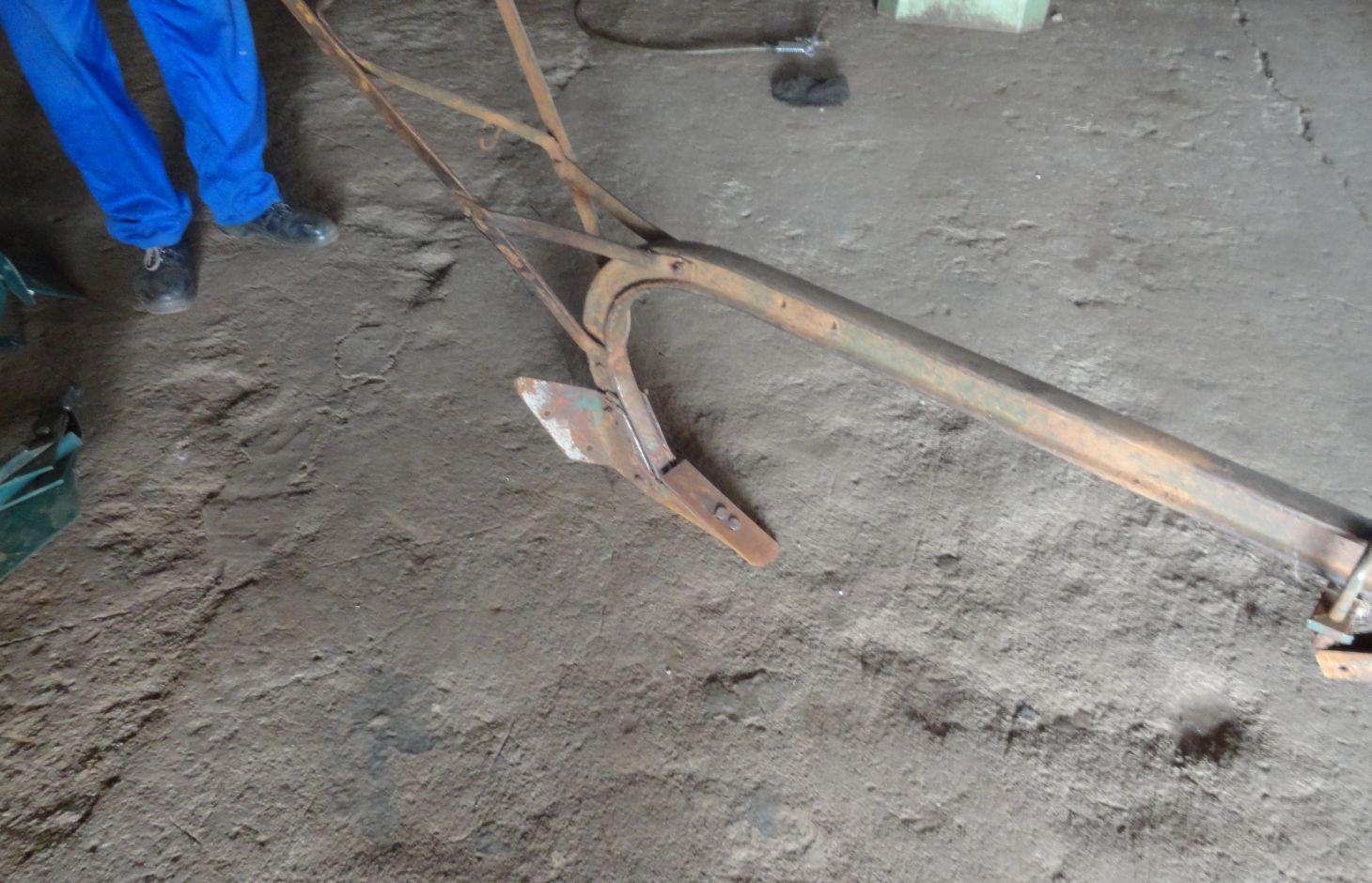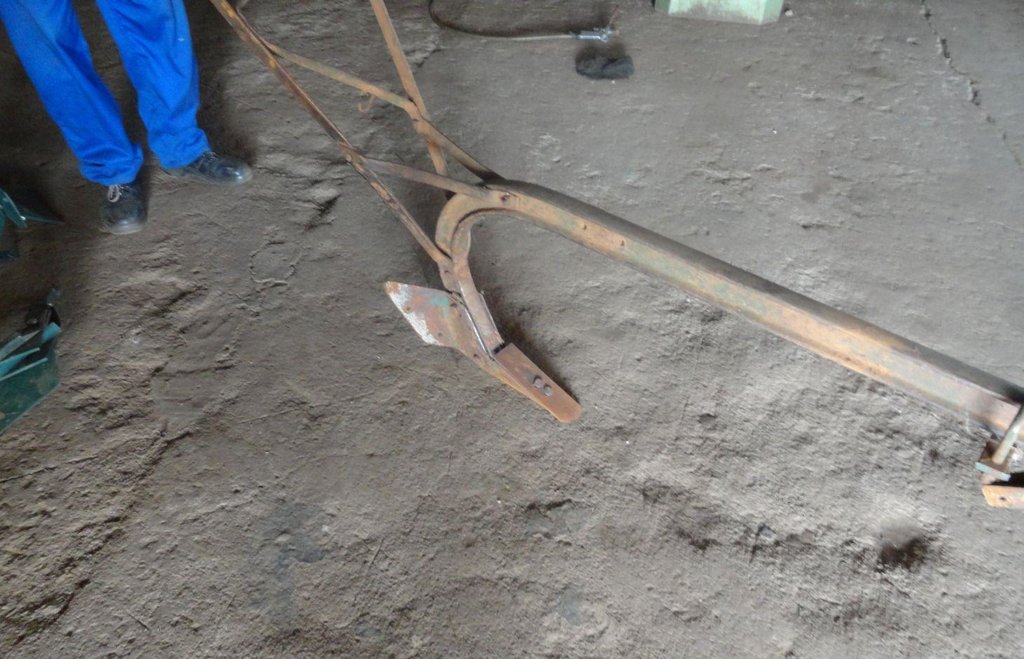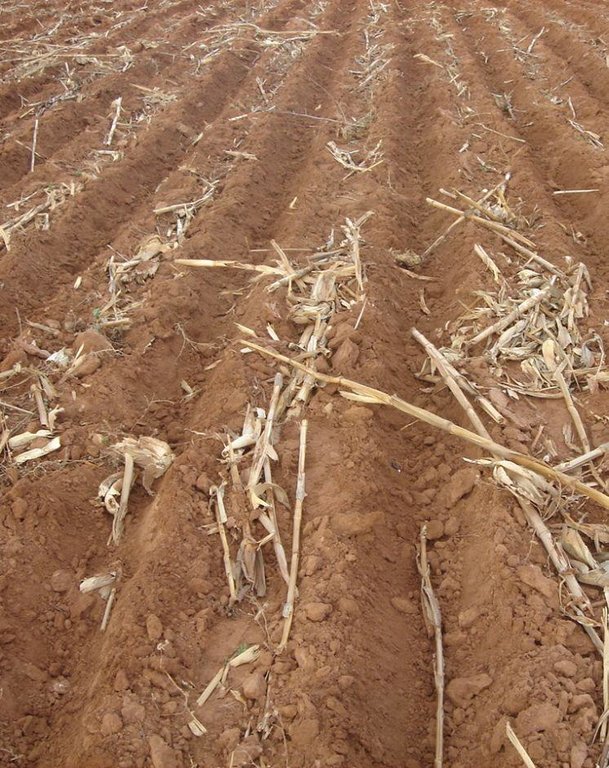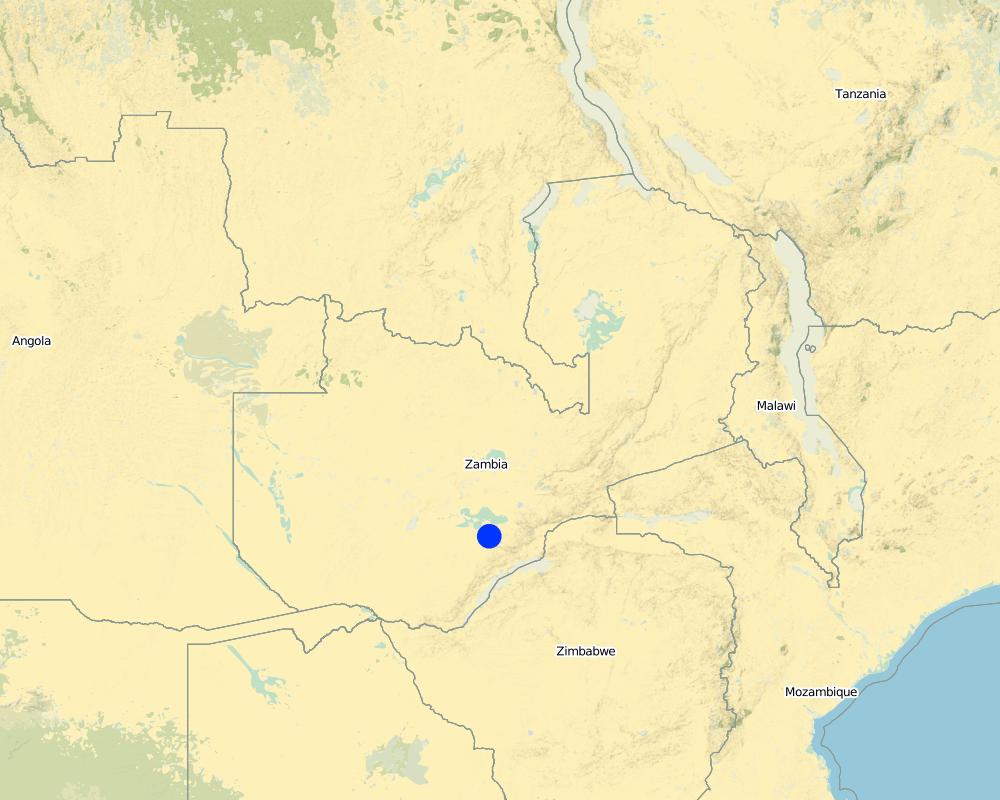Conservation Tillage with Magoye Ripper [ប្រទេសសំប៊ី]
- ការបង្កើត៖
- បច្ចុប្បន្នភាព
- អ្នកចងក្រង៖ Silenga Wamunyima
- អ្នកកែសម្រួល៖ –
- អ្នកត្រួតពិនិត្យ Fabian Ottiger
Minimum tillage
technologies_1139 - ប្រទេសសំប៊ី
ពិនិត្យមើលគ្រប់ផ្នែក
ពង្រីកមើលទាំងអស់ បង្រួមទាំងអស់1. ព័ត៌មានទូទៅ
1.2 ព័ត៌មានលម្អិតពីបុគ្គលសំខាន់ៗ និងស្ថាប័នដែលចូលរួមក្នុងការវាយតម្លៃ និងចងក្រងឯកសារនៃបច្ចេកទេស
អ្នកជំនាញឯកទេស SLM:
អ្នកជំនាញឯកទេស SLM:
Katoweji Alfred
(+260) 211 213 739
Golden Valley Agricultural Research Trust
PO. Box 50834 Lusaka
ប្រទេសសំប៊ី
អ្នកជំនាញឯកទេស SLM:
Ndandula Sharon
(+260) 211 213 739
Golden Valley Agricultural Research Trust
PO. Box 50834 Lusaka
ប្រទេសសំប៊ី
ឈ្មោះអង្គភាពមួយ (ច្រើន) ដែលបានចងក្រងឯកសារ/ វាយតម្លៃបច្ចេកទេស (បើទាក់ទង)
Golden Valley agricultural research trust (Golden Valley agricultural research trust) - ប្រទេសសំប៊ី1.3 លក្ខខណ្ឌទាក់ទងទៅនឹងការប្រើប្រាស់ទិន្នន័យដែលបានចងក្រងតាមរយៈ វ៉ូខេត
តើពេលណាដែលទិន្នន័យបានចងក្រង (នៅទីវាល)?
15/01/2013
អ្នកចងក្រង និង(បុគ្គលសំខាន់ៗ)យល់ព្រមទទួលយកនូវលក្ខខណ្ឌនានាទាក់ទងទៅនឹងការប្រើប្រាស់ទិន្នន័យដែលបានចងក្រងតាមរយៈវ៉ូខេត:
បាទ/ចា៎
1.5 ការយោងទៅលើកម្រងបញ្ជីសំណួរនៃវិធីសាស្ត្រផ្សព្វផ្សាយ SLM
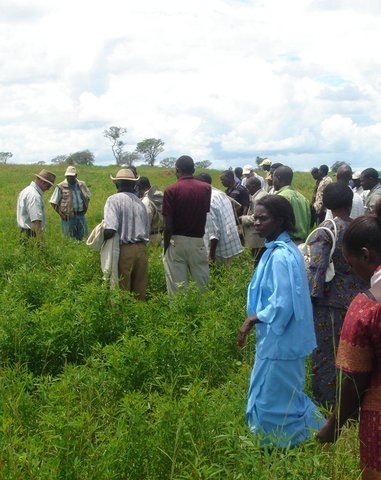
Participatory Research and Development [ប្រទេសសំប៊ី]
This is a collaborative process between researchers and farmers for developing and adapting new technologies that focus on incorporating the perspectives and inputs from the farmers into the development process.
- អ្នកចងក្រង៖ Arthur Chomba
2. ការពណ៌នាពីបច្ចេកទេស SLM
2.1 ការពណ៌នាដោយសង្ខេបពីបច្ចេកទេស
និយមន័យបច្ចេកទេស:
Conservation Tillage with the Magoye Ripper is an animal draft reduced tillage method that involves the use of the Magoye Ripper to loosen the soil by shattering with a tine instead of ploughing.
2.2 ការពណ៌នាលម្អិតពីបច្ចេកទេស
ការពណ៌នា:
The Magoye Ripper is an animal drawn implement used for conservation tillage. The Ripper consists of a frame that is attached to a common plough beam and on this frame is fixed a tine at an angle that penetrates and breaks up the soil when pulled. Only the region where the crop furrow will be is loosened by the tine and by so doing reducing the amount of tillage and disruption of soil structure while preserving the crop residue cover. The frame has some ‘wings’ attached to it that throw the soil out of the ripped furrow to leave it open for planting and collecting of water. Ripping is done in one pass up to a depth of 15cm depending on the strength of the oxen, soil type, hitch assembly settings and the sharpness of the tine.
Purpose of the Technology: Reducing tillage first of all reduces tillage costs and tillage time allowing more time for the farmer to plant early and/or a bigger area. Reducing tillage also reduces the loss of soil organic matter and the destructive effects to the soil structure ultimately improving soil fertility and soil water conservation. Ripping does not invert the soil, hence it does not bury crop residues which further enhance organic matter levels and protect the soil from excessive evaporation and erosion. The open furrow left by the ripper collects water from the adjacent untilled soil much in the same way basins (zai system) are used for water harvesting. This together with the increased rooting depth resulting from the breaking of compacted soil, enhanced infiltration and early planting improves water conservation and hence the resilience of crop to extended dry spells.
Establishment / maintenance activities and inputs: The establishment of ripping based conservation tillage mainly involves the purchase of the ripper frame and the
replaceable tines. Liming acidic soils (low pH soils) followed by a final ploughing will be required to correct the soil pH which otherwise will be difficult to correct once conservation tillage has been established. The main establishment activity involves adopting a new mindset and increasing the knowledge base to apply the technology correctly. Knowledge about alternative weed control practices and herbicide use is particularly cardinal as the farmer will have to adopt new weeding practices and routines in the absence of ploughing. Maintenance activities are more or less the same as conventional tillage except for replacing the tillage tines which wear every now and then. The same applies for the inputs except for the increase in use of herbicides.
Natural / human environment: Ripping is best performed in dry season when the soil is dry although this may not be possible with some of the smaller and/or weak oxen when the soil is too dry. It is therefore recommended for farmers in regions that experience long dry seasons to rip at the end of harvest before the soils get too dry and hard and when the oxen are in good condition before they lose weight and strength due to less feed and water, excessive heat as the dry season progresses.
The ripper is mostly suited to small-scale farmers just adopting Conservation Agriculture (CA) since the tool can be easily adapted to the existing plough beam which most of the farmers already have. The small capital outlay for establishing the system makes it suited to resource poor and risk-averse farmers.
2.3 រូបភាពនៃបច្ចេកទេស
2.5 ប្រទេស/តំបន់/ទីតាំងកន្លែង ដែលបច្ចេកទេសត្រូវបានអនុវត្ត និងបានគ្រប់ដណ្តប់ដោយការវាយតម្លៃនេះ
ប្រទេស:
ប្រទេសសំប៊ី
តំបន់/រដ្ឋ/ខេត្ត:
Zambia/Southern Province
បញ្ជាក់បន្ថែមពីលក្ខណៈនៃទីតាំង:
Mazabuka/Magoye
Map
×2.6 កាលបរិច្ឆេទនៃការអនុវត្ត
ប្រសិនបើមិនច្បាស់ឆ្នាំ សូមបញ្ជាក់កាលបរិច្ឆេទដែលប្រហាក់ប្រហែល:
- 10-50 ឆ្នាំ
2.7 ការណែនាំពីបច្ចេកទេស
សូមបញ្ជាក់តើបច្ចេកទេសត្រូវបានណែនាំឱ្យអនុវត្តដោយរបៀបណា:
- ពេលកំពុងពិសោធន៍
មតិយោបល់ (ប្រភេទនៃគម្រោង ។ល។):
The Magoye Ripper was introduced in 1995 after a period of adaptive research by government research branch under a project supported by the Netherlands government.
3. ចំណាត់ថ្នាក់នៃបច្ចេកទេស SLM
3.1 គោលបំណងចម្បង (១ ឬច្រើន) នៃបច្ចេកទេសនេះ
- កាត់បន្ថយ, បង្ការ, ស្តារឡើងវិញនូវការធ្លាក់ចុះគុណភាពដី
3.2 ប្រភេទដីប្រើប្រាស់មួយប្រភេទ (ច្រើនប្រភេទ) ដែលបានអនុវត្តបច្ចេកទេស

ដីដាំដំណាំ
- ដំណាំប្រចាំឆ្នាំ
ដំណាំចម្បង (ដំណាំកសិ-ឧស្សាហកម្ម និងដំណាំស្បៀង) :
Major cash crop: Cotton, maize
Major food crop: Maize
Major other crops: Groundnuts

ចម្រុះ (ដំណាំ/ វាលស្មៅ/ ដើមឈើ)គិតទាំងកសិរុក្ខកម្ម
- ដីដាំដំណាំ និងចិញ្ចឹមសត្វ
ផលិតផល/សេវាកម្មចម្បង:
Main species seminomadism/pastoralism: Cattle, goats, pigs
មតិយោបល់:
Major land use problems (compiler’s opinion): Loss of soil structure and loss of soil fertility
Major land use problems (land users’ perception): Droughts and dry dpells
Livestock is grazing on crop residues
3.3 ព័ត៌មានបន្ថែមអំពីអ្នកប្រើប្រាស់ដី
ការផ្គត់ផ្គង់ទឹកនៅកន្លែងអនុវត្តបច្ចេកទេស:
- ទឹកភ្លៀង
ចំនួនសារដែលដាំដំណាំក្នុងមួយឆ្នាំ:
- 1
សូមបញ្ជាក់:
Longest growing period in days: 135 Longest growing period from month to month: Mid November to end of March
ដង់ស៊ីតេនៃសត្វចិញ្ចឹម (បើពាក់ព័ន្ធ):
1-10 LU /km2
3.4 ក្រុម SLM ដែលបច្ចេកទេសស្ថិតនៅក្នុង
- កាត់បន្ថយការរំខានដល់ដី
3.5 ការសាយភាយនៃបច្ចេកទេស
បញ្ជាក់ពីការសាយភាយនៃបច្ចេកទេស:
- ត្រូវបានផ្សព្វផ្សាយត្រឹមតំបន់មួយ
ប្រសិនបើបច្ចេកទេសត្រូវបានសាយភាយពាសពេញតំបន់ណាមួយ សូមកំណត់ទំហំផ្ទៃដីអនុវត្តន៍:
- 0.1-1 គម2
មតិយោបល់:
250 rippers were distributed in Magoye and surveys show that only about half of these farmers continued to use the ripper. The field sizes range from 1/4ha to 1/2ha.
3.6 វិធានការ SLM ដែលបញ្ចូលនូវបច្ចេកទេស

វិធានការក្សេត្រសាស្ត្រ
- A2: សារធាតុសរីរាង្គ/ជីជាតិដី
- A6៖ ផ្សេងៗ
មតិយោបល់:
Main measures: agronomic measures
Specification of other agronomic measures: Reduced Tillage, Crop Residues
Type of agronomic measures: early planting, mulching, manure / compost / residues, mineral (inorganic) fertilizers, soil conditioners (lime, gypsum), rotations / fallows, breaking compacted topsoil, minimum tillage, non-inversion tillage, furrows (drainage, irrigation), breaking compacted subsoil
3.7 កំណត់ប្រភេទនៃការធ្លាក់ចុះគុណភាពដីសំខាន់ៗដែលបច្ចេកទេសនេះបានដោះស្រាយ

ការហូរច្រោះដីដោយសារទឹក
- Wt: ការបាត់ដីស្រទាប់លើដោយការហូរច្រោះ

ការធ្លាក់ចុះសារធាតុគីមីក្នុងដី
- Cn: ការថយចុះជីជាតិ និងកាត់បន្ថយបរិមាណសារធាតុសរីរាង្គ (មិនកើតឡើងដោយការហូរច្រោះទេ)

ការបាត់បង់រូបសាស្ត្រនៃដី
- Pc: ការហាប់ណែន

ការធ្លាក់ចុះជីវសាស្ត្រនៃដី
- Bl: ការបាត់បង់មីក្រូ និងម៉ាក្រូសរីរាង្គរបស់ដី
មតិយោបល់:
Main type of degradation addressed: Cn: fertility decline and reduced organic matter content, Pc: compaction, Bl: loss of soil life
Secondary types of degradation addressed: Wt: loss of topsoil / surface erosion
Main causes of degradation: soil management (Over-ploughing), crop management (annual, perennial, tree/shrub) (Monocropping), overgrazing (Crop residues overgrazed leaving land exposed), poverty / wealth (under application of fertilizer leading to nutrient mining, charcoal burning)
Secondary causes of degradation: deforestation / removal of natural vegetation (incl. forest fires) (Charcoal burning), Heavy / extreme rainfall (intensity/amounts) (high intensity storms leading to erosion), droughts (resulting in inadequate soil cover), land tenure (communal land over-exploited), governance / institutional (lack of credit facilities)
3.8 ការពារ កាត់បន្ថយ ឬស្តារឡើងវិញនៃការធ្លាក់ចុះគុណភាពដី
បញ្ជាក់ពីគោលដៅរបស់បច្ចេកទេស ដែលផ្តោតទៅការធ្លាក់ចុះគុណភាពដី:
- ការកាត់បន្ថយការធ្លាក់ចុះគុណភាពដី
មតិយោបល់:
Secondary goals: prevention of land degradation, rehabilitation / reclamation of denuded land
4. បច្ចេកទេសជាក់លាក់ សកម្មភាពអនុវត្ត ធាតុចូល និងថ្លៃដើម
4.1 គំនូសបច្ចេកទេសនៃបច្ចេកទេសនេះ
ឈ្មោះអ្នកនិពន្ធ:
Silenga Wamunyima, Box 670577, Mazabuka, Zambia
4.2 លក្ខណៈពិសេសនៃបច្ចេកទេស/ ពណ៌នាពីគំនូរបច្ចេកទេស
Planting rip lines are done at a depth of 15-20 cm with inter row of 75 or 90 cm, 30-40 cm depth of the furrow of ripping can be achieved. This is achieved by running the ripper through the same rip line twice so that the tine gets deeper into the soil. The width of the open furrow is 10-15 cm wide. Ripping is done across the slope to reduce runoff. Ripping is best performed and recommended done in the dry season.
Location: Magoye. Mazabuka/Southern Province/Zambia
Date: 2014-06-29
Technical knowledge required for field staff / advisors: high (The use of the Ripper itself is simple but applying it as part of a conservation agriculture system can be knowledge demanding.)
Technical knowledge required for land users: moderate (adapting the production system to accommodate the Ripper will require learning new practices for weeding, planting and fertility management.)
Main technical functions: improvement of ground cover, improvement of topsoil structure (compaction), improvement of subsoil structure (hardpan), increase of infiltration, water harvesting / increase water supply
Secondary technical functions: control of raindrop splash, improvement of surface structure (crusting, sealing), increase in organic matter, increase in nutrient availability (supply, recycling,…), increase / maintain water stored in soil, increase of groundwater level / recharge of groundwater
Early planting
Material/ species: maize, cotton
Quantity/ density: 44,000 pla
Remarks: 25cm intra row by 75cm
Mulching
Material/ species: crop residues
Quantity/ density: 3ton/ha
Remarks: uniformly spread
Manure / compost / residues
Material/ species: residues
Quantity/ density: 3ton/ha
Remarks: uniformly spread
Mineral (inorganic) fertilizers
Material/ species: Basal and top dressing
Quantity/ density: 400kg/ha
Remarks: spot application
Soil conditioners (lime, gypsum)
Material/ species: lime
Quantity/ density: 1ton/ha
Rotations / fallows
Material/ species: maize in rotation with cotton, groundnuts and cowpeas
Breaking compacted topsoil
Material/ species: Ripping with Magoye Ripper at 15cm depth
Remarks: 75cm or 90cm row spacing
Minimum tillage
Material/ species: ripping
Non-inversion tillage
Material/ species: ripping
Furrows (drainage, irrigation)
Material/ species: ripped lines leave furrows for water harvesting
Breaking compacted subsoil
Material/ species: deep ripping at 20cm
4.3 ព័ត៌មានទូទៅដែលពាក់ព័ន្ធនឹងការគណនាធាតុចូល និងថ្លៃដើម
ផ្សេងៗ/ រូបិយប័ណ្ណជាតិ (បញ្ជាក់):
Kwacha
កំណត់អត្រាប្តូរប្រាក់ពីដុល្លាទៅរូបិយប័ណ្ណតំបន់ (បើទាក់ទង)៖ 1 ដុល្លារ =:
5,0
កំណត់ថ្លៃឈ្នួលជាមធ្យមនៃការជួលកម្លាំងពលកម្មក្នុងមួយថ្ងៃ:
2.40
4.4 សកម្មភាពបង្កើត
| សកម្មភាព | ប្រភេទវិធានការ | ពេលវេលា | |
|---|---|---|---|
| 1. | Purchase magoye ripper | ក្សេត្រសាស្ត្រ | |
| 2. | Purchase knapsack sprayer | ក្សេត្រសាស្ត្រ |
មតិយោបល់:
Lifespan of the magoye ripper: 7 years
Lifespan of the Knapsack sprayer: 5 years
4.5 ថ្លៃដើម និងធាតុចូលដែលត្រូវការសម្រាប់ការបង្កើតបច្ចេកទេស
| បញ្ជាក់ពីធាតុចូល | ឯកតា | បរិមាណ | ថ្លៃដើមក្នុងមួយឯកតា | ថ្លៃធាតុចូលសរុប | % នៃថ្លៃដើមដែលចំណាយដោយអ្នកប្រើប្រាស់ដី | |
|---|---|---|---|---|---|---|
| សម្ភារៈ | Magoye ripper | Tool | 1,0 | 50,0 | 50,0 | 100,0 |
| សម្ភារៈ | Knapsack sprayer | Tool | 1,0 | 80,0 | 80,0 | 100,0 |
| ថ្លៃដើមសរុបក្នុងការបង្កើតបច្ចេកទេស | 130,0 | |||||
មតិយោបល់:
Duration of establishment phase: 5 month(s)
4.6 សកម្មភាពថែទាំ
| សកម្មភាព | ប្រភេទវិធានការ | ពេលវេលា/ ភាពញឹកញាប់ | |
|---|---|---|---|
| 1. | slashing and spreading residues | ក្សេត្រសាស្ត្រ | May-June yearly after harvest |
| 2. | Ripping | ក្សេត្រសាស្ត្រ | May-June after harvest |
| 3. | Liming | ក្សេត្រសាស្ត្រ | Nov-Dec before planting |
| 4. | Planting and fertilizing | ក្សេត្រសាស្ត្រ | Nov-Dec at onset of rains |
| 5. | chemical weeding | ក្សេត្រសាស្ត្រ | 3 times |
| 6. | harvesting | ក្សេត្រសាស្ត្រ | April-May |
4.7 កំណត់ថ្លៃដើមសម្រាប់ការថែទាំ/ សកម្មភាពរបស់បច្ចេកទេស (ក្នុងរយៈពេលមួយឆ្នាំ)
| បញ្ជាក់ពីធាតុចូល | ឯកតា | បរិមាណ | ថ្លៃដើមក្នុងមួយឯកតា | ថ្លៃធាតុចូលសរុប | % នៃថ្លៃដើមដែលចំណាយដោយអ្នកប្រើប្រាស់ដី | |
|---|---|---|---|---|---|---|
| កម្លាំងពលកម្ម | Slashing and spreading residues | ha | 1,0 | 20,0 | 20,0 | 100,0 |
| កម្លាំងពលកម្ម | Ripping | ha | 1,0 | 50,0 | 50,0 | 100,0 |
| កម្លាំងពលកម្ម | Liming | ha | 1,0 | 42,0 | 42,0 | 100,0 |
| កម្លាំងពលកម្ម | Planting and fertilizing | ha | 1,0 | 40,0 | 40,0 | 100,0 |
| សម្ភារៈដាំដុះ | Seeds | kg | 20,0 | 2,5 | 50,0 | 100,0 |
| ជី និងសារធាតុពុល | Fertilizer | kg | 400,0 | 0,8 | 320,0 | 100,0 |
| ផ្សេងៗ | Herbicides | liters | 5,0 | 6,0 | 30,0 | 100,0 |
| ផ្សេងៗ | Labour: Chemical weeding | ha | 1,0 | 24,0 | 24,0 | 100,0 |
| ផ្សេងៗ | Labour: Harvesting | ha | 1,0 | 20,0 | 20,0 | 100,0 |
| ថ្លៃដើមសរុបសម្រាប់ការថែទាំដំណាំតាមបច្ចេកទេស | 596,0 | |||||
មតិយោបល់:
Machinery/ tools: Magoye Ripper
Calculation are for a 1ha of maize under magoye ripper based conservation tillage and costs are for the Zambia situation in Magoye as of August 2012.
4.8 កត្តាសំខាន់បំផុតដែលមានឥទ្ធិពលដល់ការចំណាយ
ពណ៌នាពីកត្តាប៉ះពាល់ចម្បងៗទៅលើថ្លៃដើម:
The weed control method employed is the main determinate factor depending on whether the farmer uses hand hoe or herbicides. Abandoning ploughing leads to higher weed densities leading to increased labour requirements/recurrent costs if hand weeding is used. However, with herbicides the weeding labour demand and costs cost are much lower by a factor of about 5. Another major cost is that of fertilizer which makes up about half the cost hence the total cost will vary significantly depending on fertilizer cost.
5. លក្ខណៈបរិស្ថានធម្មជាតិ និងមនុស្ស
5.1 អាកាសធាតុ
បរិមាណទឹកភ្លៀងប្រចាំឆ្នាំ
- < 250 មម
- 251-500 មម
- 501-750 មម
- 751-1,000 មម
- 1,001-1,500 មម
- 1,501-2,000 មម
- 2,001-3,000 មម
- 3,001-4,000 មម
- > 4,000 មម
លក្ខណៈពិសេស/ មតិយោបល់លើរដូវភ្លៀង:
Average rainfall 700mm, summer rains from November to March.
តំបន់កសិអាកាសធាតុ
- មានភ្លៀងតិចតួច
Thermal climate class: subtropics. 3 distinct seasons – summer, winter and one rainy season
5.2 សណ្ឋានដី
ជម្រាលជាមធ្យម:
- រាបស្មើ (0-2%)
- ជម្រាលតិចតួច (3-5%)
- មធ្យម (6-10%)
- ជម្រាលខ្ពស់បន្តិច (11-15%)
- ទីទួល (16-30%)
- ទីទួលចោត (31-60%)
- ទីទួលចោតខ្លាំង (>60%)
ទម្រង់ដី:
- ខ្ពង់រាប
- កំពូលភ្នំ
- ជម្រាលភ្នំ
- ជម្រាលទួល
- ជម្រាលជើងភ្នំ
- បាតជ្រលងភ្នំ
តំបន់តាមរយៈកម្ពស់ :
- 0-100 ម
- 101-500 ម
- 501-1,000 ម
- 1,001-1,500 ម
- 1,501-2,000 ម
- 2,001-2,500 ម
- 2,501-3,000 ម
- 3,001-4,000 ម
- > 4,000 ម
មតិយោបល់ និងបញ្ចាក់បន្ថែមអំពីសណ្ឋានដី :
Slopes on average: Also flat and moderate (classed 2) and rolling (classed 3)
5.3 ដី
ជម្រៅដីជាមធ្យម:
- រាក់ខ្លាំង (0-20 សម)
- រាក់ (21-50 សម)
- មធ្យម (51-80 សម)
- ជ្រៅ (81-120 សម)
- ជ្រៅខ្លាំង (> 120 សម)
វាយនភាពដី (ស្រទាប់លើ):
- មធ្យម (ល្បាយ, ល្បាប់)
- ម៉ត់/ ធ្ងន់ (ឥដ្ឋ)
សារធាតុសរីរាង្គនៅស្រទាប់ដីខាងលើ:
- មធ្យម (1-3%)
- ទាប (<1%)
បើអាចសូមភ្ជាប់ការពណ៌នាពីដីឱ្យបានច្បាស់ ឬព័ត៌មានដែលអាចទទួលបាន ឧ. ប្រភេទដី, pH ដី/ ជាតិអាស៊ីត, សមត្ថភាពផ្លាស់ប្តូរកាចុង, វត្តមាននីត្រូសែន, ភាពប្រៃ ។ល។:
Soil fertility: Low (classed 1) and medium (classed 2, low fertility caused mainly by poor soil management practices, otherwise soil are inherently fertile)
Topsoil organic matter: Low (classed 1) and medium (classed 2, due to excessive ploughing and nutrient mining)
Soil drainage/infiltration: Good (classed 1, soils naturally are well drained except were soil have bee compacted by poor management practices) and medium (classed 2)
Soil water storage capacity: Medium (classed 1, soils mostly loam to sandy loam with medium storage capacity) and low (ranked 2)
5.4 ទឹកដែលអាចទាញមកប្រើប្រាស់បាន និងគុណភាពទឹក
នីវ៉ូទឹកក្រោមដី:
> 50 ម
ទឹកលើដីដែលអាចទាញយកប្រើប្រាស់បាន:
កម្រិតមធ្យម
គុណភាពទឹក (មិនបានធ្វើប្រត្តិកម្ម):
ទឹកពិសារដែលមានគុណភាពល្អ
មតិយោបល់ និងលក្ខណៈពិសេសផ្សេងៗទៀតលើគុណភាព និងបរិមាណទឹក :
Ground water table: <50m (ranked 1, hand wells are <20m but reliable boreholes are > 50m) and 5-50m (ranked 2)
Availability of surface water: Medium (mostly seasonal streams and dams)
Water quality (untreated): Good drinking water (ranked 1, from hand pumps (both communal and private)) and poor drinking water (treatment required, from hand dug wells, ranked 1 also)
5.5 ជីវៈចម្រុះ
ភាពសម្បូរបែបនៃប្រភេទ:
- កម្រិតមធ្យម
មតិយោបល់ និងលក្ខណៈពិសេសផ្សេងទៀតលើជីវចម្រុះ:
Human population densities are relatively low
5.6 លក្ខណៈនៃអ្នកប្រើប្រាស់ដីដែលអនុវត្តបច្ចេកទេស
ចំណូលក្រៅកសិកម្ម:
- 10-50% នៃចំណូល
កម្រិតជីវភាព:
- មិនល្អខ្លាំង
- មិនល្អ
ឯកជន ឬក្រុម:
- ធ្វើខ្លួនឯង/ គ្រួសារ
យេនឌ័រ:
- បុរស
សូមបញ្ជាក់ពីលក្ខណៈពាក់ព័ន្ធផ្សេងទៀតអំពីអ្នកប្រើប្រាស់ដី:
Land users applying the Technology are mainly common / average land users
Difference in the involvement of women and men: The technology is applied mostly by men since most households are male headed and animal traction operation are reserved for men. Planting and weeding operations are the domain of women and children
Population density: 10-50 persons/km2
Annual population growth: 3% - 4%
8% of the land users are rich and own 15% of the land (own more than 10 cattle).
8% of the land users are average wealthy and own 15% of the land (own between 5 and 10 cattle).
16% of the land users are poor and own 20% of the land (own less than 5).
68% of the land users are poor and own 40% of the land (do not own cattle).
Off-farm income specification: sale of rainfed crops makes up about half of their income, the remainder coming from sale of livestock, petty trading, hiring out labour and remittances
Market orientation of production system: Mixed (subsistence/ commercial, sale of excess maize and cotton, dairy, ranked 1) and subsistence (self-supply, livestock, maize and legumes for home consumption, ranked 2),
Level of mechanization: Animal traction (ranked 1, families without cattle borrow or hire), mechanised (ranked 2) and manual labour (ranked 2, only for small backyard fields)
5.7 ទំហំផ្ទៃដីជាមធ្យមនៃដីផ្ទាល់ខ្លួន ឬជួលគេដែលបានអនុវត្តបច្ចេកទេស
- < 0.5 ហិកតា
- 0.5-1 ហិកតា
- 1-2 ហិកតា
- 2-5 ហិកតា
- 5-15 ហិកតា
- 15-50 ហិកតា
- 50-100 ហិកតា
- 100-500 ហិកតា
- 500-1,000 ហិកតា
- 1,000-10,000 ហិកតា
- > 10,000 ហិកតា
តើផ្ទៃដីនេះចាត់ទុកជាទំហំកម្រិតណាដែរ ខ្នាតតូច មធ្យម ឬខ្នាតធំ (ធៀបនឹងបរិបទតំបន់)?
- ខ្នាតតូច
មតិយោបល់:
Average area of land owned or leased by land users applying the Technology: Also: 5-15 ha, 15-50 ha, 50-100 ha
5.8 ភាពជាម្ចាស់ដី កម្មសិទ្ធប្រើប្រាស់ដី និងកម្មសិទ្ធប្រើប្រាស់ទឹក
ភាពជាម្ចាស់ដី:
- ឯកជន មិនមានកម្មសិទ្ធ
កម្មសិទ្ធិប្រើប្រាស់ដី:
- អាស្រ័យផលសេរី (មិនមានការកំណត់)
- ឯកជន
- Land is apportioned by traditional leaders
កម្មសិទ្ធប្រើប្រាស់ទឹក:
- អាស្រ័យផលសេរី (មិនមានការកំណត់)
- Land is apportioned by traditional leaders
5.9 ការប្រើប្រាស់សេវាកម្ម និងហេដ្ឋារចនាសម្ព័ន្ធ
សុខភាព:
- មិនល្អ
- មធ្យម
- ល្អ
ការអប់រំ:
- មិនល្អ
- មធ្យម
- ល្អ
ជំនួយបច្ចេកទេស:
- មិនល្អ
- មធ្យម
- ល្អ
ការងារ (ឧ. ការងារក្រៅកសិដ្ឋាន):
- មិនល្អ
- មធ្យម
- ល្អ
ទីផ្សារ:
- មិនល្អ
- មធ្យម
- ល្អ
ថាមពល:
- មិនល្អ
- មធ្យម
- ល្អ
ផ្លូវ និងការដឹកជញ្ជូន:
- មិនល្អ
- មធ្យម
- ល្អ
ទឹកផឹក និងអនាម័យ:
- មិនល្អ
- មធ្យម
- ល្អ
សេវាកម្មហិរញ្ញវត្ថុ:
- មិនល្អ
- មធ្យម
- ល្អ
6. ផលប៉ះពាល់ និងការសន្និដ្ឋាន
6.1 ផលប៉ះពាល់ក្នុងបរិវេណអនុវត្តបច្ចេកទេសដែលកើតមាន
ផលប៉ះពាល់លើសេដ្ឋកិច្ចសង្គម
ផលិតផល
ផលិតកម្មដំណាំ
គុណភាពមុន SLM:
1.8ton/ha
គុណភាពក្រោយ SLM:
2ton/ha
មតិយោបល់/ ការបញ្ជាក់:
mostly due to early planting
ផលិតកម្មចំណីសត្វ
មតិយោបល់/ ការបញ្ជាក់:
crop residues needed for soil cover
ហានិភ័យនៃភាពបរាជ័យរបស់ផលិតកម្ម
មតិយោបល់/ ការបញ្ជាក់:
Better tolerance to dry spells
ផ្ទៃដីផលិតកម្ម
គុណភាពក្រោយ SLM:
20%
ចំណូល និងថ្លៃដើម
ការចំណាយលើធាតុចូលកសិកម្ម
មតិយោបល់/ ការបញ្ជាក់:
purchase of herbicides
ចំណូលក្នុងកសិដ្ឋាន
គុណភាពក្រោយ SLM:
15%
មតិយោបល់/ ការបញ្ជាក់:
due to lower tillage cost, better yield
បន្ទុកការងារ
មតិយោបល់/ ការបញ្ជាក់:
only if herbicicdes are used for weeding
ផលប៉ះពាល់ទៅលើវប្បធម៌សង្គម
សន្តិសុខស្បៀង/ ភាពគ្រប់គ្រាន់ខ្លួនឯង
មតិយោបល់/ ការបញ្ជាក់:
due to improved yields and more time and labour to diversify
ឱកាសនៃការបង្កើតថ្មី
មតិយោបល់/ ការបញ្ជាក់:
Less time spent preparing land
ការកាត់បន្ថយជម្លោះ
មតិយោបល់/ ការបញ្ជាក់:
competition for crop residues with neighbours cattle
Improved livelihoods and human well-being
មតិយោបល់/ ការបញ្ជាក់:
Technology not yet been applied on a large enough area to make significant impact at community level but increased farm incomes among farmers has led to better education and health among household members.
ផលប៉ះពាល់ទៅលើអេកូឡូស៊ី
វដ្តទឹក/លំហូរ
គុណភាពទឹក
មតិយោបល់/ ការបញ្ជាក់:
due to improved good drainage
ការប្រមូលស្តុកទុកទឹក
មតិយោបល់/ ការបញ្ជាក់:
open furows collect water
លំហូរទឹកលើផ្ទៃដី
មតិយោបល់/ ការបញ្ជាក់:
due to better soil cover
ប្រព័ន្ធបង្ហូរទឹក
មតិយោបល់/ ការបញ្ជាក់:
due to improved soil structure
នីវ៉ូទឹកក្រោមដី/ ដង្ហើមទឹក
មតិយោបល់/ ការបញ្ជាក់:
not applied extensively
រំហួត
មតិយោបល់/ ការបញ្ជាក់:
due to better soil cover
ដី
សំណើមដី
មតិយោបល់/ ការបញ្ជាក់:
due to resulting improved soil srtucture
គម្របដី
មតិយោបល់/ ការបញ្ជាក់:
Due to non-inversion tillage
ការបាត់បង់ដី
មតិយោបល់/ ការបញ្ជាក់:
Due to less soil disturbance and better soil cover
ដីប្រេះ
មតិយោបល់/ ការបញ្ជាក់:
Due to less soil disturbance
ដីហាប់
មតិយោបល់/ ការបញ្ជាក់:
Due to less soil disturbance
វដ្តនៃសារធាតុចិញ្ចឹម/ការទទួលបាន
មតិយោបល់/ ការបញ្ជាក់:
Due to less soil disturbance
ភាពប្រៃ
មតិយោបល់/ ការបញ្ជាក់:
due to resulting good drainage
សារធាតុសរីរាង្គដី/ការបូនក្រោមដី
មតិយោបល់/ ការបញ្ជាក់:
Due to less soil disturbance
ជីវចម្រុះ៖ ដំណាំ, សត្វ
ជីវម៉ាស/ កាបូនលើដី
មតិយោបល់/ ការបញ្ជាក់:
Due to less soil disturbance
ភាពសម្បូរបែបនៃសត្វ
មតិយោបល់/ ការបញ្ជាក់:
due to increased soil organic matter (SOM)
ផលប៉ះពាល់ទៅលើអេកូឡូស៊ីផ្សេងៗ
Waterlogging
មតិយោបល់/ ការបញ្ជាក់:
Open furrow collect water in times of excess rainfal
Soil erosion locally
មតិយោបល់/ ការបញ្ជាក់:
If furrow are made along the slope
6.2 ផលប៉ះពាល់ក្រៅបរិវេណអនុវត្តបច្ចេកទេសដែលកើតមាន
ទឹកដែលអាចទាញមកប្រើប្រាស់បាន
មតិយោបល់/ ការបញ្ជាក់:
only if applied on a large scale
លំហូរទឹកដែលអាចប្រើប្រាស់បាននៅរដូវប្រាំង
មតិយោបល់/ ការបញ្ជាក់:
only if applied on a large scale
ទឹកជំនន់ខ្សែទឹកខាងក្រោម
មតិយោបល់/ ការបញ្ជាក់:
only if applied on a large scale
កំណកល្បាប់ខ្សែទឹកខាងក្រោម
មតិយោបល់/ ការបញ្ជាក់:
only if applied on a large scale
ទឹកក្រោមដី/ ការបំពុលទឹកទន្លេ
មតិយោបល់/ ការបញ្ជាក់:
only if applied on a large scale
ខូចខាតដល់ស្រែអ្នកជិតខាង
មតិយោបល់/ ការបញ្ជាក់:
only if applied on a large scale
6.3 ភាពប្រឈម និងភាពរួសនៃបច្ចេកទេសទៅនឹងការប្រែប្រួលអាកាសធាតុ និងគ្រោះអាកាសធាតុ/ គ្រោះមហន្តរាយ (ដែលដឹងដោយអ្នកប្រើប្រាស់ដី)
ការប្រែប្រួលអាកាសធាតុ
ការប្រែប្រួលអាកាសធាតុ
| រដូវកាល | ប្រភេទនៃការប្រែប្រួលអាកាសធាតុ/ព្រឹត្តិការណ៍ | លក្ខណៈឆ្លើយតបនៃបច្ចេកទេសទៅនឹងការប្រែប្រួលអាកាសធាតុ | |
|---|---|---|---|
| សីតុណ្ហភាពប្រចាំឆ្នាំ | កើនឡើង | មិនស្គាល់ |
គ្រោះអាកាសធាតុ (មហន្តរាយ)
គ្រោះមហន្តរាយធម្មជាតិ
| លក្ខណៈឆ្លើយតបនៃបច្ចេកទេសទៅនឹងការប្រែប្រួលអាកាសធាតុ | |
|---|---|
| ព្យុះភ្លៀងតាមតំបន់ | មិនល្អ |
| ព្យុះកំបុតត្បូងតាមតំបន់ | មិនស្គាល់ |
គ្រោះមហន្តរាយអាកាសធាតុ
| លក្ខណៈឆ្លើយតបនៃបច្ចេកទេសទៅនឹងការប្រែប្រួលអាកាសធាតុ | |
|---|---|
| រាំងស្ងួត | ល្អ |
គ្រោះមហន្តរាយទឹក
| លក្ខណៈឆ្លើយតបនៃបច្ចេកទេសទៅនឹងការប្រែប្រួលអាកាសធាតុ | |
|---|---|
| ទឹកជំនន់ទូទៅ (ទន្លេ) | មិនល្អ |
ផលវិបាកដែលទាក់ទងនឹងបរិយាកាសផ្សេងៗទៀត
ផលវិបាកដែលទាក់ទងនឹងបរិយាកាសផ្សេងៗទៀត
| លក្ខណៈឆ្លើយតបនៃបច្ចេកទេសទៅនឹងការប្រែប្រួលអាកាសធាតុ | |
|---|---|
| កាត់បន្ថយពេលដាំដុះ | ល្អ |
មតិយោបល់:
Magoye ripper based conservation tillage should be applied in well drained fields to avoid water-logging in the ripped furrows during seasons of excess rainfall or events of heavy downpours.
6.4 ការវិភាគថ្លៃដើម និងអត្ថប្រយោជន៍
តើផលចំណេញ និងថ្លៃដើមត្រូវបានប្រៀបធៀបគ្នាយ៉ាងដូចម្តេច (ទស្សនៈរបស់អ្នកប្រើប្រាស់ដី)?
រយៈពេលខ្លី:
វិជ្ជមាន
រយៈពេលវែង:
វិជ្ជមានខ្លាំង
តើផលចំណេញ និងការថែទាំ/ ជួសជុលត្រូវបានប្រៀបធៀបគ្នាយ៉ាងដូចម្តេច (ទស្សនៈរបស់អ្នកប្រើប្រាស់ដី)?
រយៈពេលខ្លី:
វិជ្ជមាន
រយៈពេលវែង:
វិជ្ជមានខ្លាំង
មតិយោបល់:
Timely planting enables larger areas to be planted and better yields. In the long term, improved soil fertility and soil structure results in sustained improved yields. However, if herbicides are not used, the costs and labour requirements of weeding can result in negative benefits.
6.5 ការទទួលយកបច្ចេកទេស
មតិយោបល់:
250 land user families have adopted the Technology with external material support
Comments on acceptance with external material support: The farmers bought the Magoye Rippers at half price and over half of them abandoned the technology after the first or second year of use.
Comments on spontaneous adoption: Information on spontaneous adoption is not documented although there have been reports of this in other districts.
There is a little trend towards spontaneous adoption of the Technology
Comments on adoption trend: Availability of replacement tines and the increased weed challenge have been a major hindrances to widespread adoption.
6.7 ភាពខ្លាំង/ គុណសម្បត្តិ/ ឱកាសនៃបច្ចេកទេស
| ភាពខ្លាំង/ គុណសម្បត្តិ/ ឱកាសនៅកន្លែងរបស់អ្នកប្រើប្រាស់ដី |
|---|
|
Enables early planting How can they be sustained / enhanced? planting with the first heavy rainfall in November |
| ភាពខ្លាំង/ គុណសម្បត្តិ/ ឱកាស ទស្សនៈរបស់បុគ្គលសំខាន់ៗ |
|---|
|
necessitates early planting How can they be sustained / enhanced? Plant in November or early December with the onset of rainfall |
|
fewer operations hence lower costs How can they be sustained / enhanced? continuous emphasis on early land preparation (May to July/August) |
|
conserves water and soil How can they be sustained / enhanced? encourage crop diversification and crop rotation legumes |
6.8 ភាពខ្សោយ/ គុណវិបត្តិ/ ហានិភ័យនៃបច្ចេកទេស និងវិធីសាស្ត្រដោះស្រាយ
| ភាពខ្សោយ/ គុណវិបត្តិ/ ហានិភ័យ ទស្សនៈរបស់អ្នកប្រើប្រាស់ដី | តើបច្ចេកទេសទាំងនោះបានដោះស្រាយបញ្ហាដូចម្តេច? |
|---|---|
| weeding is difficult when herbicides are not used | train land users on how to use herbicides |
| ripping is hardly attained in heavy soils in October | rip between May and July |
| ភាពខ្សោយ/ គុណវិបត្តិ/ ហានិភ័យ ទស្សនៈរបស់អ្នកចងក្រងឬបុគ្គលសំខាន់ៗ | តើបច្ចេកទេសទាំងនោះបានដោះស្រាយបញ្ហាដូចម្តេច? |
|---|---|
| weed pressure | encourage land users to use herbicides and continuous weeding |
7. ឯកសារយោង និងវេបសាយ
7.2 ឯកសារយោងដែលបានចេញផ្សាយ
ចំណងជើង អ្នកនិពន្ធ ឆ្នាំ ISBN:
Impact study on the acceptance of the Magoye Ripper, Piet Stevens, David Samazaka, Ab Wanders, Douglas Moono, 2002
មានប្រភពមកពីណា? ថ្លៃដើមប៉ុន្មាន?
GART/free
ចំណងជើង អ្នកនិពន្ធ ឆ្នាំ ISBN:
Social-economic analysis of conservation agriculture in southern Africa, FAO, 2011
មានប្រភពមកពីណា? ថ្លៃដើមប៉ុន្មាន?
FAO/free online
ចំណងជើង អ្នកនិពន្ធ ឆ្នាំ ISBN:
Conservation farming in Zambia, Steven Haggblade, Gelson Tembo, October 2003
មានប្រភពមកពីណា? ថ្លៃដើមប៉ុន្មាន?
INDABA Project, Michigan State University/free online.
ចំណងជើង អ្នកនិពន្ធ ឆ្នាំ ISBN:
Conservation farming in Zambia, Conservation farming unit (CFU), 2011
មានប្រភពមកពីណា? ថ្លៃដើមប៉ុន្មាន?
cfu@zamnet.zm
ការតភ្ជាប់ និងម៉ូឌុល
ពង្រីកមើលទាំងអស់ បង្រួមទាំងអស់ការតភ្ជាប់

Participatory Research and Development [ប្រទេសសំប៊ី]
This is a collaborative process between researchers and farmers for developing and adapting new technologies that focus on incorporating the perspectives and inputs from the farmers into the development process.
- អ្នកចងក្រង៖ Arthur Chomba
ម៉ូឌុល
គ្មានម៉ូឌុល


